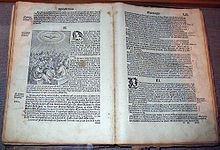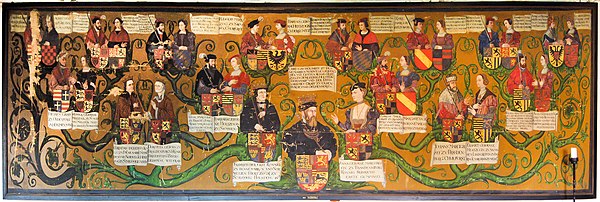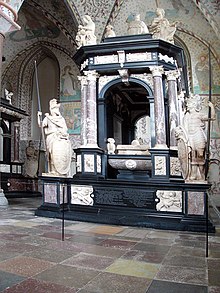Christian III (Denmark and Norway)

Christian III (* August 12, 1503 at Gottorf Castle ; † January 1, 1559 at Koldinghus ) was King of Denmark and Norway from 1534 to 1559 .
Life
Christian III was the eldest son of King Frederick I of Denmark and Norway and his first wife Anna of Brandenburg . Christian III was an ardent Lutheran and introduced the Reformation in Denmark , Norway and Iceland . He promoted agriculture and trade and published a Danish translation of the Bible (1550). Denmark-Norway experienced a tremendous upswing under his reign .
During a trip abroad he attended the Diet of Worms in 1521 ; the meeting with Martin Luther made an indelible impression on him.
In 1523 his father gave him the management of part of the Duchy of Schleswig with the Hadersleben center , where he introduced the Reformation .
On April 8, 1529, the Flensburg disputation took place in the Franciscan monastery in Flensburg, chaired by the Crown Prince, which led to the introduction of the Reformation in Denmark and Schleswig-Holstein .
Quarrels for the throne and feuds of counts
When Frederick I died on April 10, 1533, Christian's councilor Melchior Rantzau hurried to the Netherlands to conclude an alliance with Emperor Charles V that would pave the way for Christian to take the throne . This treaty was signed on May 5, 1533. However, the Catholic-dominated Danish Imperial Council refused to elect the Lutheran-inspired Christian as king ; the election was postponed until the following year. During this period Denmark and Norway were without a king . The Lutheran minority in the Reichsrat, together with the mayors of Copenhagen and Malmö, offered Duke Christian the throne, but the latter rejected it. He also preferred to forego the support of Lübeck and the Hanseatic League instead of going into new dependencies. The two mayors then campaigned for Christian II , who was imprisoned at Sønderborg Castle , to be reinstated with the help of Count Christoph von Oldenburg and Lübeck. This triggered the so-called count feud .
Christian only took over royal power after a request from the Imperial Council after Lübeck and his allies attacked Denmark in 1534 and won their first victories. The nobility selected him at a meeting in the Church of Sct. Sören zu Rye on July 4, 1534. The Imperial Council had to transfer a large part of its power to the king before Christian accepted the election.
In his election surrender it says in § 3 :
"Och efftherthij att Norgis riige nw saa forringget er bode aff magtt och formwæ, och Norgis riigis jndbiggere jcke aldene formwæ att vnderholde thennom ænn herre och konnyng, och samme rimarige er dog forbundet e attics tone hoes ... thet heer effther weere och bliffwe vnder Danmarcks krone, liige som eth aff the other lande, Jutland, Fyenn, Sielandt eller Skonæ eere, och her effther jcke weere eller hede jngtet koninge riige for seg, menn eth ledemodt aff Danmaronecks riige och till eternal tiidt. "
“After the kingdom of Norway has been reduced so much in power and wealth and the inhabitants of the kingdom of Norway alone are unable to maintain a lord and king and since this kingdom is now connected with Denmark's crown for ever [...] so it should be listed below To be and remain Denmark's crown just like the other countries of Jutland, Funen, Zealand and Skåne and from now on are no longer called a kingdom, but a member of the kingdom of Denmark for ever. "
This ended Norway's statehood.
Christian III at the beginning of his rule only had control of Jutland . In September, skipper Clement also motivated citizens and farmers to rebel in northern Jutland. The uprising was put down and Clement fled Aalborg with the troops of Johann Rantzau on his neck. He was soon caught and hanged in Viborg on September 9, 1535 . The corpse was quartered and displayed, and a lead crown was placed on the severed head.
In the spring of 1535 Christian's army crossed to Funen , where Johann Rantzau won the decisive victory over the now divided opponents in the battle of Øksnebjerg on June 11th . Around the same time, a Danish-Swedish fleet under the leadership of Peder Skrams defeated the Lübeck fleet near Svendborgsund . On July 29, 1536, 33-year-old Christian took Copenhagen and Denmark was once again a united kingdom.
In Norway, the southern and northern divisions of the Imperial Council had different opinions about the successor to Frederick I. Bishop Olav Engelbrektsson reigned in the northern parts , and he opposed a Lutheran king with all his might and forced the other council members to confront them. But since the feud of the count ended with a total victory for Christian and he sent his troops to Norway, Olav had to leave the country. The Reichsrat recognized Christian III. 1537 as king and was dissolved, and Norway lost its independence.
Introduction of the Reformation
On August 12, 1536, the king had three Catholic bishops arrested, partly to break the resistance against the Reformation, partly to pay off the debts to the large army of mercenaries by expropriating considerable church property . Martin Luther sent his congratulations to the king. The Reformation was introduced in Denmark and Norway with the church order of Johannes Bugenhagen . The Danish royal city of Nyborg thus became the secular center of the Reformation, with which the king was able to further consolidate his power, because the church property fell to the crown and the Lutheran clergy were state officials.
Schleswig-Holstein
In 1544 the duchies of Schleswig and Holstein were between Christian III. and his half-brothers Johann the Elder and Adolf I. split. Christian became Duke of the royal share, Adolf von Schleswig-Holstein-Gottorf and Johann von Schleswig-Holstein-Hadersleben . For his stays in the Krempe Fortress , Christian III. there the so-called royal court .
Marriage and offspring

In 1525 Christian married Princess Dorothea von Sachsen-Lauenburg (1511–1571), daughter of Duke Magnus I von Sachsen-Lauenburg , with whom he had five children:
- Anna (born November 22, 1532 - † October 1, 1585)
- ∞ August , Elector of Saxony
- Frederick II (July 1, 1534 - April 4, 1588), succeeded Christian on the Danish and Norwegian throne.
- Magnus (born August 14, 1540; † March 18, 1583), Duke of Holstein, Bishop of Ösel-Wiek (1560–1572) and Courland (1560–1583), King of Livonia (1570–1577)
- Johann (March 25, 1545 - October 9, 1622)
- Dorothea (June 29, 1546 - January 6, 1617)
ancestors
| Dietrich von Oldenburg (1390–1440) | |||||||||||||
| King Christian I (1426–1481) | |||||||||||||
| Heilwig von Holstein (1400–1436) | |||||||||||||
| King Friedrich I (1471–1533) | |||||||||||||
| Johann Margrave of Brandenburg-Kulmbach (1406–1464) | |||||||||||||
| Dorothea of Brandenburg-Kulmbach (1430–1495) | |||||||||||||
| Barbara of Saxony-Wittenberg (1405–1465) | |||||||||||||
| Christian III King of Denmark and Norway | |||||||||||||
| Albrecht Achilles , Elector of Brandenburg (1414–1486) | |||||||||||||
| Johann Cicero Elector of Brandenburg (1455–1499) | |||||||||||||
| Margarete of Baden (1431-1457) | |||||||||||||
| Anna of Brandenburg (1487–1514) | |||||||||||||
| William III. Duke of Saxony (1425–1482) | |||||||||||||
| Margaret of Saxony (1449–1501) | |||||||||||||
| Anna of Austria (1432–1462) | |||||||||||||
See also
literature
- Georg Waitz: Christian III. In: Allgemeine Deutsche Biographie (ADB). Volume 4, Duncker & Humblot, Leipzig 1876, pp. 184-188.
- Wilhelm Jensen: Christian III .. In: New German Biography (NDB). Volume 3, Duncker & Humblot, Berlin 1957, ISBN 3-428-00184-2 , p. 233 f. ( Digitized version ).
- Ralph Tuchtenhagen : CHRISTIAN III. In: Biographisch-Bibliographisches Kirchenlexikon (BBKL). Volume 17, Bautz, Herzberg 2000, ISBN 3-88309-080-8 , Sp. 234-236.
- Heinz Scheible: Melanchthon's correspondence people 11
Web links
Individual evidence
- ^ Andreas Oeding, Broder Schwensen, Michael Sturm: Flexikon. 725 aha experiences from Flensburg! , Flensburg 2009, article: Lutherpark
| predecessor | Office | successor |
|---|---|---|
| Friedrich I. |
King of Denmark 1534–1559 |
Friedrich II. |
| Friedrich I. |
King of Norway 1534–1559 |
Friedrich II. |
| personal data | |
|---|---|
| SURNAME | Christian III |
| BRIEF DESCRIPTION | King of Denmark and Norway |
| DATE OF BIRTH | August 12, 1503 |
| PLACE OF BIRTH | Gottorf Castle |
| DATE OF DEATH | January 1, 1559 |
| Place of death | Koldinghus |

